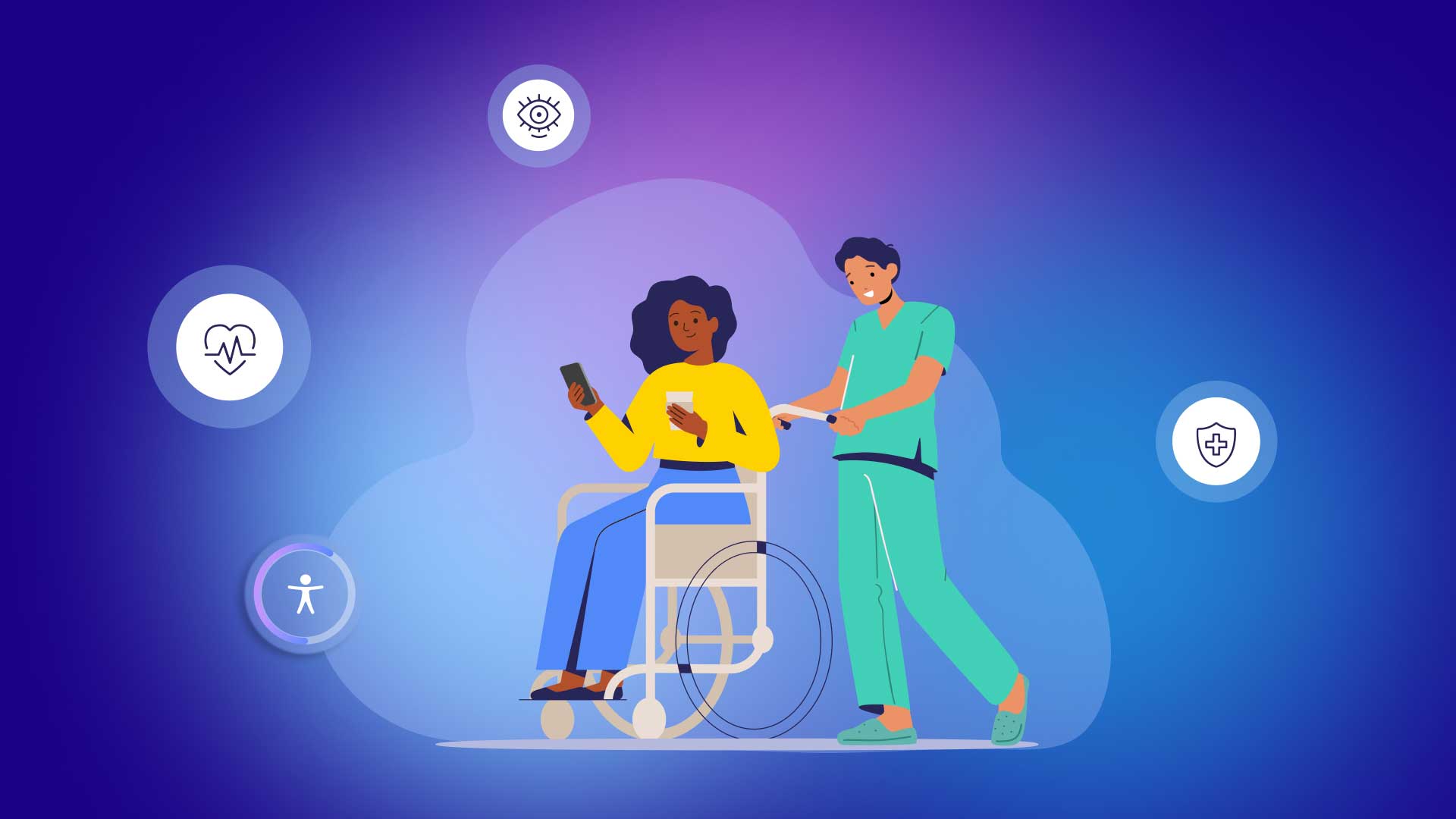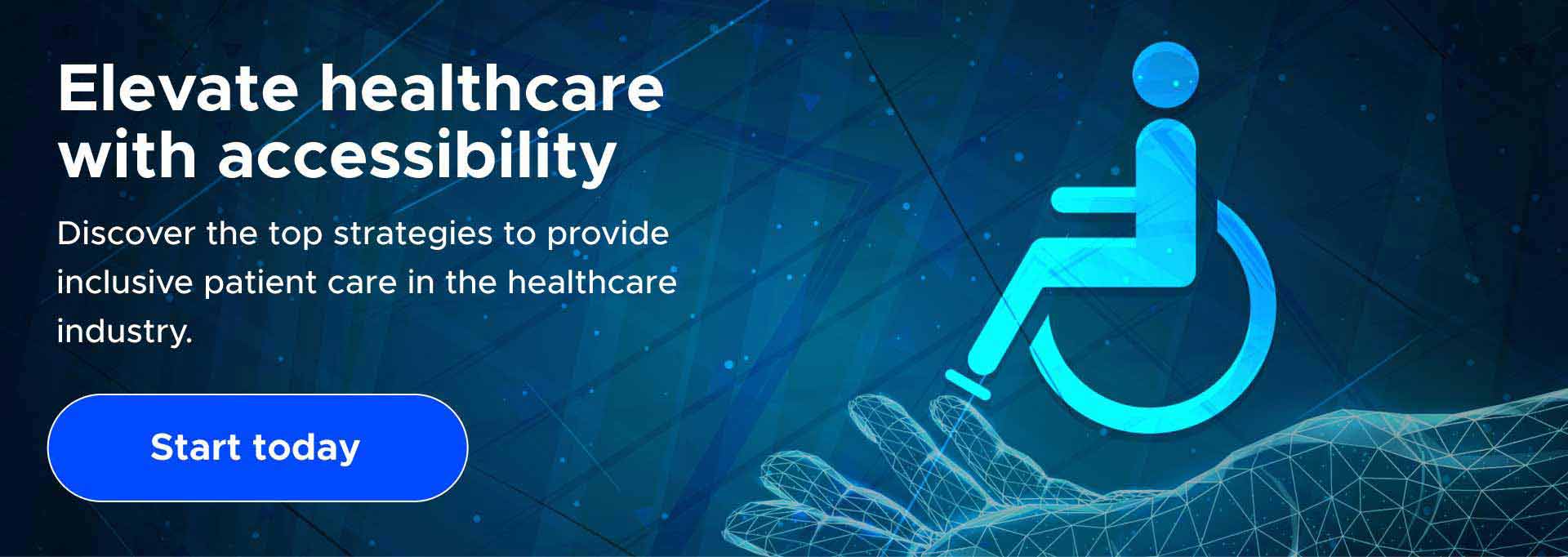Healthcare & Accessibility: 5 Strategies for Inclusive Patient Care

Accessible online medical care is critical for everyone, especially those who live with a disability. Accessible healthcare services should be a universal right, but the digital accessibility journey is filled with challenges that demand expertise and action.
Patients’ demands for a seamless healthcare journey change as they become more technologically adept. Traditional services alone are no longer enough—the new expectation is equitable healthcare accessibility policies. So, online healthcare accommodations for people with disabilities will only grow more critical in the future.
A recent study revealed that 56% of patients desire enhanced digital options to manage their care, underscoring the pressing need for professionals constructing healthcare’s digital infrastructure to take decisive action. In truth, inequities in healthcare access can adversely affect the health of people who are blocked from the information, services, and products they need.
How can the healthcare sector move beyond limited, one-size-fits-all approaches to care? How can professionals working on digital healthcare solutions build inclusive digital platforms, such as telehealth and online doctor services, with accessibility at the core?
This blog will explore the advantages of the digital healthcare sector, shedding light on five key strategies that enable the healthcare industry to anchor every decision with accessibility in mind.
What is digital healthcare?
Digital healthcare uses information and communication technologies (ICT) to enhance and streamline healthcare delivery. It covers various tools and services to improve patient care, healthcare system efficiency, and public health.
Here are some critical components of digital healthcare:
Electronic Health Records (EHRs)
EHRs digitize patient health information, making it easier for healthcare providers to track a patient’s medical history, treatments, and health outcomes. EHRs can improve care coordination, enhance decision-making, and reduce errors.
Telemedicine
This digital approach is remote delivery of healthcare services and clinical information through digital platforms. It empowers individuals with mobility limitations with in-home healthcare services to consult with healthcare professionals from their homes, which is especially beneficial for those in remote areas.
Online doctors
Online doctors are integral components of the digital healthcare revolution. They transform equitable healthcare access by providing personalized, real-time consultation and care, irrespective of geographical barriers or physical mobility constraints.
mHealth
Mobile health, or mHealth, uses devices like smartphones and wearables to deliver health services and information, including fitness and wellness apps, medication reminders, remote patient monitoring, and more.
Health Informatics
This field involves data analytics and big data to inform healthcare decisions. By analyzing large sets of health data, providers can identify trends, improve patient care, and even predict outbreaks.
AI in Healthcare
Artificial intelligence and machine learning algorithms can support healthcare in numerous ways, such as predicting disease, personalizing treatments, automating administrative tasks, and powering clinical decision support systems.
While digital healthcare technologies can improve the healthcare market’s delivery of care, they can also overlook considerations around accessibility, exacerbating barriers to using them effectively. Let’s look at examples of how telehealth solutions can become more inclusive.
Telehealth solutions and digital accessibility
Beyond designing disability-friendly, accessible healthcare facilities in the physical world, telehealth platforms continue to evolve. Moreover, the importance of integrating digital accessibility into their design and operation becomes increasingly evident. Here are a few ways that we can bring accessibility into healthcare to reach as many people as possible:
1. Conformity with Web Content Accessibility Guidelines (WCAG)
To ensure healthcare solutions are accessible, providers must adhere to universally accepted accessibility guidelines, such as WCAG. These measures include providing alt text for non-text content, captions, and other multimedia options and presenting content differently while retaining relevant information.
2. Interface and Design Considerations
Telehealth solutions should be designed with simple and intuitive user interfaces, considering users’ varied needs. Always use clear and large fonts, high-contrast colors, and easy-to-navigate menus. Some platforms also allow for personalization, allowing users to adjust the settings to meet their needs.
3. Assistive Technology Compatibility
Ensure your healthcare access platforms are compatible with screen readers for the visually impaired, speech recognition software for mouse or keyboard navigation, and compatibility with hearing aids or cochlear implants for individuals with hearing impairments.
4. Accessible Content
Medical information is often complex, and telehealth providers should strive to ensure content is easy to understand. Simplifying content can mean using plain language, offering information in multiple languages, or providing content in various formats, such as video or audio, in addition to text. Create a usable and accessible website for patients in line with compliance accessibility guidelines to ensure equal access for all patients.
5. Digital Literacy Support
Providers often offer support and training to help users navigate their telehealth platforms, addressing potential barriers posed by limited digital literacy. This support can include user manuals, video tutorials, and dedicated helpline support.
While these are necessary steps toward ensuring digital accessibility, it’s critical to continuously test and receive feedback from diverse users, including those with disabilities, to make improvements and ensure the platforms meet people’s needs.
Recent protection from the Department of Health and Human Services
Equal healthcare access can be hard to find, whether due to physical limitations like scales that can’t accommodate wheelchairs or inaccessible medical sites and apps. Fortunately, the Department of Health and Human Services has implemented a new rule bolsters protection against disability discrimination. It covers new web tech standards for digital accessibility and strengthens protective guidelines under Section 504 of the Rehabilitation Act.
An era of accessibility for the healthcare sector
Medical institutions must prioritize patients in their digital evolution and deliver an inclusive user experience to maintain a competitive edge and comply with healthcare accessibility laws. A top-tier platform should provide convenience for patients, reduce friction, and create seamless user experiences. The healthcare sector can amplify patient satisfaction and engagement by allocating resources to people with disabilities. Applying these resources to the proper digital infrastructure enhances efficiency and opens a digital front door for all.
UserWay: making healthcare inclusive
UserWay’s AI-powered technology can help you provide accessible healthcare. Many providers already benefit from UserWay’s suite of accessibility tools, which transform the healthcare experience for all individuals, regardless of their abilities or limitations. With these digital innovations, you can break down barriers that patients experience and ensure everyone can access healthcare information and services. Join us in creating a genuinely inclusive healthcare environment for all individuals.
FAQS
What does digital healthcare entail, and why is it important?
Digital healthcare utilizes telemedicine, mobile health, and AI to improve patient care and system efficiency.
How can telehealth solutions ensure digital accessibility?
Telehealth can foster accessibility by adhering to WCAG guidelines, creating user-friendly designs, and offering compatibility with assistive technologies.
How can AI-powered solutions like UserWay contribute to inclusive healthcare?
UserWay’s AI-powered tools help create an inclusive healthcare environment by enabling accessible information and services for all individuals.





Share